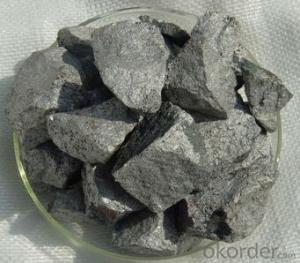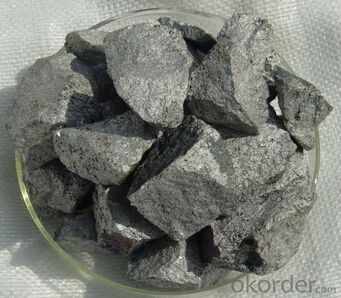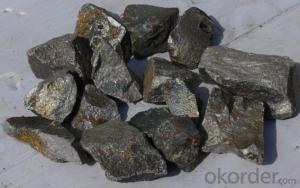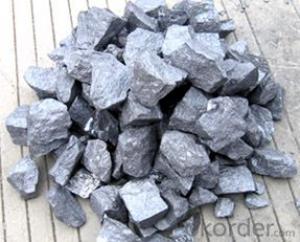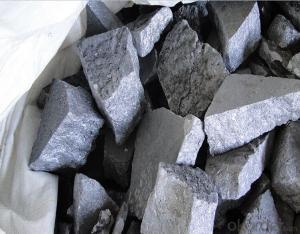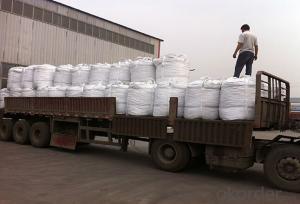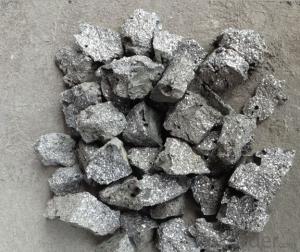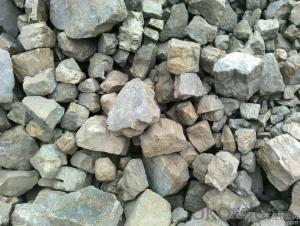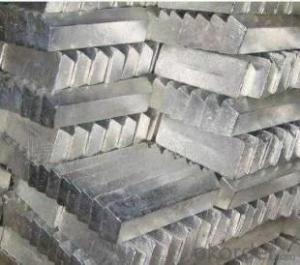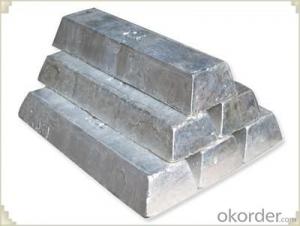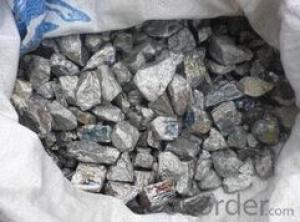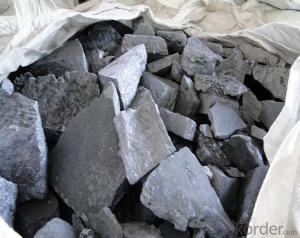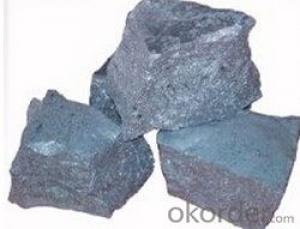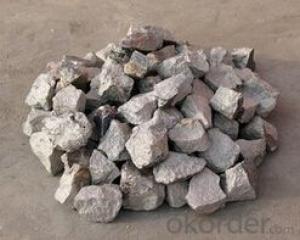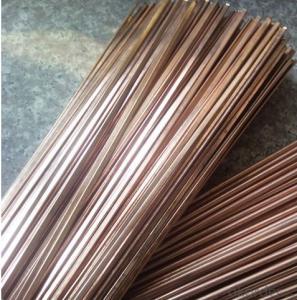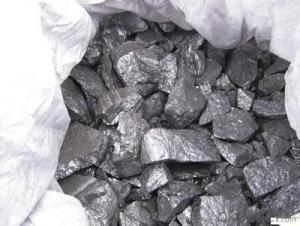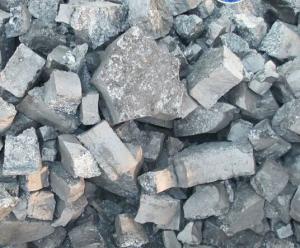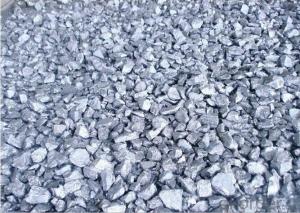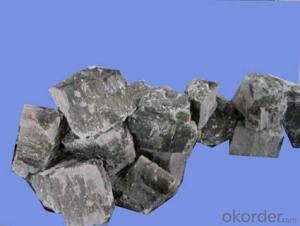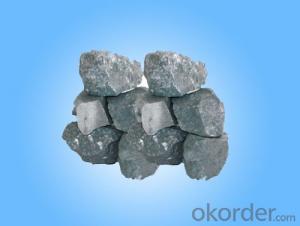High Qaulity Ferromolybdenum FeMo
- Loading Port:
- China Main Port
- Payment Terms:
- TT OR LC
- Min Order Qty:
- -
- Supply Capability:
- -
OKorder Service Pledge
OKorder Financial Service
You Might Also Like
Specifications
1.Ferro Molybdenum
2.Brand:FeMo75,FeMo70, FeMo60-A ,FeMo55-A
3.Size range:10 to 150mm
4.Make stainless steel
High Qaulity Ferromolybdenum (FeMo ) Mo60 ,Mo65
Specifications
1.Composition:Fe,Mn,Si,S,P,C,Cu,Sb,Sn
2.Brand:FeMo70,FeMo70Cu1,
3.Size range:10 to 150mm
4.Make stainless,heatresistant steel
Application:FERROMOLYBDENUM 70 is mainly used to add molybdenum to steel in steel making. Molybdenum is mixed with other alloy elements to be widely used to make stainless steel, heat resistant steel, acid-resistant steel and tool steel. And it is also used to produce the alloy which has especially physical properties. To add molybdenum to iron casting can improve strength and abrasion resistance.
Properties: To add molybdenum to steel makes steel to have uniform fine-grained structure and improve hardenability of steel to eliminate temper brittleness. Molybdenum can substitute a volume of tungsten in high speed steel.
Chemical Compositions(GB/T3649-1987)
Brand | Chemical Compositions (%) | |||||||
Mn | Si | S | P | C | Cu | Sb | Sn | |
≤ | ||||||||
FeMo70 | 65~75 | 1.5 | 0.10 | 0.05 | 0.10 | 0.5 | - | - |
FeMo70Cu1 | 65~75 | 2.0 | 0.10 | 0.05 | 0.10 | 1.0 | - | - |
FeMo70Cu1.5 | 65~75 | 2.5 | 0.20 | 0.10 | 0.10 | 1.5 | - | - |
FeMo60-A | 55~65 | 1.0 | 0.10 | 0.04 | 0.10 | 0.5 | 0.04 | 0.04 |
FeMo60-B | 55~65 | 1.5 | 0.10 | 0.05 | 0.10 | 0.5 | 0.05 | 0.06 |
FeM0o60-C | 55~65 | 2.0 | 0.15 | 0.05 | 0.20 | 1.0 | 0.08 | 0.08 |
FeMo60 | ≥60 | 2.0 | 0.10 | 0.05 | 0.15 | 0.5 | 0.04 | 0.04 |
FeMo55-A | ≥55 | 1.0 | 0.10 | 0.08 | 0.20 | 0.5 | 0.05 | 0.06 |
FeMo55-B | ≥55 | 1.5 | 0.15 | 0.10 | 0.25 | 1.0 | 0.08 | 0.08 |
4. Shape:FERROMOLYBDENUM 70 should be delivered in lump or powder.
5. Size: Its size range is from 10 to 150mm. the quality of this product whose particle size range is less than 10mm×10mm should not exceed 5% of the total quality of this product.
6. Package: 100kg per iron bucke
FACTORY:
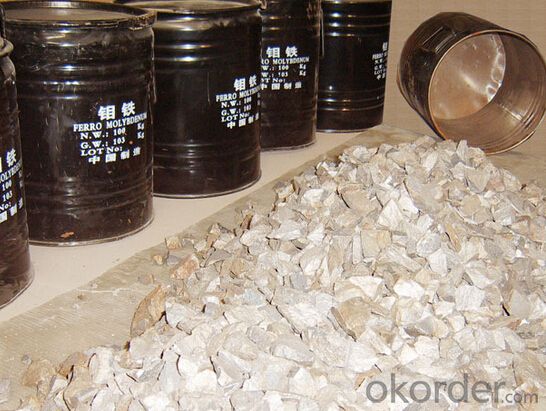
- Q: What is the resistivity of the yg13 cemented carbide?
- Two, production processProportioning, mixing, crushing, drying, fully add sifted molding agent, then drying and sieving to prepare a mixture, pressing, mixing and granulating (Germany imported vacuum pressure sintering furnace), low pressure sintering and sintering the blank test after (nondestructive ultrasonic inspection), blank size accuracy test.
- Q: Carbide die how to calculate weight, that is to say, its kg weight
- The density of tungsten, cobalt and titanium carbide is 9.7~13.2, and the higher the content of titanium carbide, the lower the density.
- Q: How to distinguish the authenticity of Zhuzhou diamond brand cemented carbide blade?
- In fact, now only look at the packaging has been unable to identify, because now the copycat alloy packaging has really not with what two things, want to know after the authenticity can be used, you can try to buy a small amount of alloy, the quality of clearance to buy a lot, you can go to the station to find the Alibaba China @ Rui Sen # trade. Easy% Co., reputation has been good, but sales of hard alloy Zhuzhou diamond factory, there are quality problems can return shipping.
- Q: What are the parameters of the wear resistance of cemented carbides in addition to their hardness?
- Even the best knives in the world, if not1, reasonable processing parameters;2 、 proper installation and use;3 、 timely maintenanceAnd so on, it will turn into a scrap of iron in a short time.
- Q: Make cutting dosage
- In general, T alloys are mainly used to process ferrous metals, because T alloys contain Ti elements (solid solutions), which can effectively reduce the flank wear and wear resistance of the crater, thereby increasing the tool life;G alloy is mainly used to process non-ferrous metals and non metals, because the G alloy can achieve more sharp tool tip and reduce the cutting force effectively.
- Q: What is the heat treatment process of cemented carbide?
- To put it plainly, that is, hardening of cemented carbide, that is, heating to a certain temperature, insulation for a certain period of time, and then suddenly into the inert gas, so that it suddenly cooling.. The same as steel quenching. After quenching generally tempered, to eliminate the stress produced by quenching, it is mainly to change the bonding phase components, that is, the organizational structure, improve the strength of cemented carbide, hardness and comprehensive performance
- Q: Customers ask whether cemented carbide can be used in the food industry! ~
- Yes, but try not to use regular brands to choose special non-toxic ingredients.
- Q: What are the types and types of carbide inserts?
- This problem suggests that you find a famous brand of knives, and then ask for a sample of knives to understand, such as the three high, Walter, Kenna and so on. Because this thing has many points, can not simply understand. According to the processing equipment, it may be divided into carbide inserts for lathe cutting, carbide inserts for milling and carbide inserts for boring. According to the different processing materials, can be divided into non-ferrous metal, used for cast iron, alloy steel. It can also be classified according to the materials used in carbide inserts, such as cubic boron nitride. A thorough understanding of the proposals used. The carbide blade is a general term (outlined) that covers too wide a range of types and models. Just like you ask, "what's the Chinese surname? What's the name?"". Unanswerable.
- Q: Hard alloy and cast iron join together, use temperature 150 degrees, what glue is better to use?
- Carbide and cast iron are preferred welding methods. Instead of bonding.Can use oxygen acetylene flame gas welding (high combustion temperature, acetylene to hard alloy is heated to a suitable temperature, can be used instead of propane gas), first to the hard alloy is heated to (dark observation) small red, give heating. Were mixed with borax and boric acid as flux, HS201 copper wire dip brazing flux hard alloy and cast iron welding.Bonding shall be considered without welding conditions.The cast iron and carbide surface is polished with fine sandpaper. A soft cloth for wiping dirt and grinding residue. 1:1 AB glue evenly, smear on the contact surface of cast iron and hard alloy. Slightly pressurized. Set aside for 12 hours.
- Q: What does P stand for and what is 30? What are its advantages and disadvantages? What is suitable for processing?
- ISO (International Organization for Standardization) will be divided into carbide alloy P, M, K three categories, P class equivalent to China's YT class, the main ingredient is WC-TiC-Co;In order to be processed in different cutting conditions of material grade, in the P class with 01-50 number between that from the highest hardness to a series of alloys for maximum toughness between P30, roughly equivalent to the YT5 of our country;This kind of cemented carbide has the highest strength and best impact resistance in YT (P), but it has poor wear resistance. It is suitable for intermittent roughing of general carbon steel and alloy steel.
Send your message to us
High Qaulity Ferromolybdenum FeMo
- Loading Port:
- China Main Port
- Payment Terms:
- TT OR LC
- Min Order Qty:
- -
- Supply Capability:
- -
OKorder Service Pledge
OKorder Financial Service
Similar products
Hot products
Hot Searches
